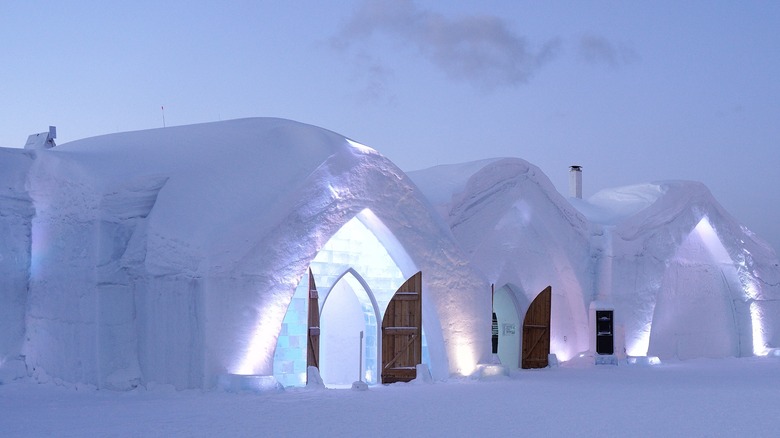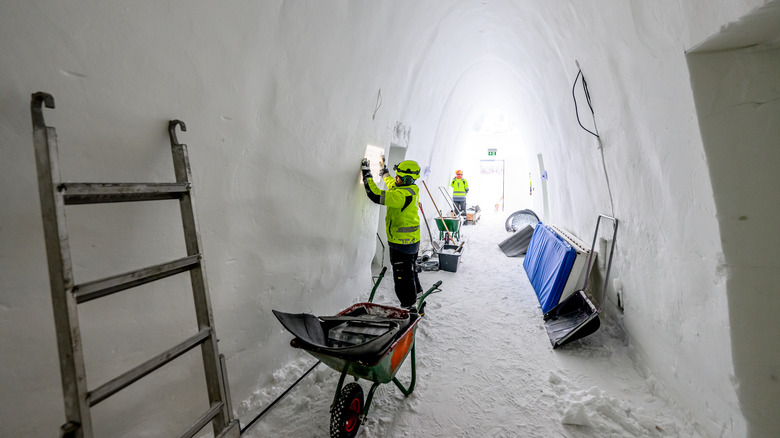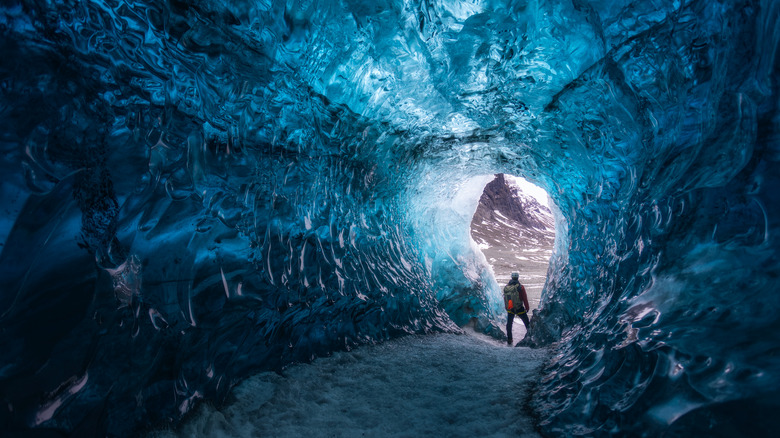Here's Why You Won't Be Able To Find An Authentic Ice Hotel In Iceland
Iceland attracts adrenaline-seekers, nature lovers, and anyone searching for unique travel experiences — from heli-skiing to whale watching. However, despite its frigid reputation, you might be surprised to learn that Iceland does not have any ice hotels. The quintessential ice hotel (or James Bond ice palace) with intricately carved structures, glistening interiors, and sub-zero accommodations are found only in places like Finland, Norway, Canada, and a handful of other countries.
The primary reason for the absence of ice hotels in Iceland is the country's relatively mild winter climate — which, again, sounds like a contradiction given the name "Iceland." Thanks to the Gulf Stream and persistent volcanic activity, Iceland experiences much warmer temperatures than one might expect. While winter temperatures can drop below freezing, they generally hover around the freezing point (32 degrees Fahrenheit), especially in the southern part of the country, where most tourists visit. These temperatures cannot naturally maintain the structural integrity of an ice hotel.
In contrast, destinations that do host some of the best ice hotels in the world, such as ICEHOTEL in Sweden, Hôtel de Glace in Canada, and Ice Village Tomamu in Japan's northern Hokkaido prefecture, experience much colder and more stable winter temperatures. These conditions are ideal for constructing and sustaining the ice and snow structures as the temperatures remain consistently below freezing for extended periods, ensuring the ice hotels don't melt or become unstable.
Logistical, economical, and environmental issues
Building and maintaining an ice hotel is an enormous logistical challenge. It requires a stable supply of thousands of tonnes of ice and snow and cold enough temperatures to ensure that the structures remain intact throughout the season. Ice hotels are only open for a few of the coldest months of the year, only to melt later in the summer and then be rebuilt again next winter. They are essentially like massive igloos, and the temperature inside is a consistently cold and crisp 23 degrees Fahrenheit.
Ice hotel projects also require significant expertise and resources. The process involves building ice structures, crafting ice sculptures, and ensuring that the interior spaces are comfortable for guests. It can take nearly 100 people to construct an ice hotel, involving a production team of artists, architects, builders, and many other professionals. The costs and risks associated with these endeavors are high, and given the unpredictable weather conditions in Iceland, an ice hotel is just not feasible.
Constructing an ice hotel could also pose environmental challenges, particularly concerning the sourcing of ice and snow. While Iceland's 269 named glaciers might seem like an obvious source, extracting ice from these glaciers could contribute to their accelerated melting and have horrific ecological impacts. Additionally, Iceland is already facing issues related to over-tourism — adding an ice hotel to the mix will potentially only make things worse, attracting even more visitors to environmentally fragile areas and increasing the strain on local resources and infrastructure.
Alternative experiences in Iceland
While Iceland may not have an authentic ice hotel, it offers many other equally unique experiences. If you're looking for an alternative accommodation option, check out Torfhús, an environmentally sustainable retreat designed like an ancient Viking village (with some modern amenities, of course). Otherwise, Iceland boasts a fair share of some of the world's most unique themed hotels, from sci-fi villain abodes like Ion Adventure Hotel to the best hotels where you can see the Northern Lights, like The Buubble Hotel.
However, if you're interested in truly icy activities, you can explore ethereal ice caves within Iceland's many glaciers, such as the Langjökull glacier, the blue ice caves of Vatnajökull glacier, or the Katla ice cave within Kötlujökull glacier. It's best to go between mid-November and early March for this activity. These caves offer a stunning and naturally occurring alternative to manufactured ice structures. You can't sleep there, but it's as close as you can get to being inside something like — or, even better than — an ice hotel!
How about warming up instead of freezing? After all, Iceland is renowned for its geothermal hot springs, like the Blue Lagoon, where visitors can soak in warm, mineral-rich waters while surrounded by snow-covered landscapes. This contrast is quintessentially Icelandic and provides a comfortable and unique way to experience the country's natural beauty. While you won't find an ice hotel in Iceland, you will find a land of fire and ice that promises unforgettable adventures.


